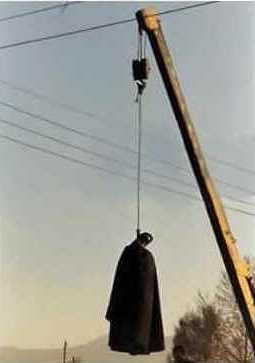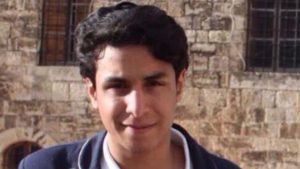
Information about Iran’s execution method
Executions in Iran are usually carried out by hanging 
Most of the countries which in the last century have executed prisoners by hanging, used the long drop method, which, if applied correctly, break the neck of the condemned and result in instant loss of consciousness.
Iran, on the other hand, use the suspension method, where the condemned is hoisted up via a winch turned by two executioners or guards, or made to stand on a simple crate which will be kicked from under him/her. Unlike the drop method, the prisoner suffers for several minutes before he/she die from asphyxiation.
The only reason for using suspension instead of long drop is to prolong the suffering of the condemned.
If the execution is public, the condemned prisoner is often hoisted into the air by a telescopic crane. Sometimes the body is left hanging for several hours.
Death penalty in Iran
Iran has one of the highest numbers of executions in the world. In 2004, Iran executed at least 159 people, which placed them second only to China.
Amnesty International recorded 69 executions between July 2005 and the end of January 2006. According to Iranian media, there were 10 executions, and 21 new death sentences were given out, between Jan. 20 and Feb. 20, 2006. According to www.stopfundamentalism.com , Iran executed at least 181 people in 2006.
There is no reason to believe that the number of executions will fall in the near future.
The usual method of execution is hanging, but Iranian law also opens for stoning as punishment for adultery and incest. In 2002 the head of the judiciary announced a moratorium on stoning. Iranian judges have later imposed sentences of stoning, but these are usually overturned higher up in the court system. However, Amnesty International has reported that in May 2006, a man and a woman was executed by stoning in a cemetery in Mashhad, by members of the Revolutionary Guard and Bassij Forces.
Since 1990, Iran is one of eight countries that are known to have executed prisoners who were under 18 years when the crime was committed. Over the last 17 years, Iran has executed at least 24 child offenders, eight of them in 2005, and four in 2006. (Full list here).
This is in direct violation of Iran’s obligations as a state party to the International Covenant on Civil and Political Rights (ICCPR) and the Convention on the Rights of the Child (CRC).
By signing them, Iran has undertaken not to execute anyone for an offense committed when they were under the age of 18. These treaties also prohibit the use of torture and cruel, inhuman, or degrading punishments.
The list of crimes that can lead to death penalty is long. Capital offenses in Iran include murder, rape, armed robbery, apostasy, blasphemy, serious drug trafficking, repeated sodomy, adultery or prostitution, treason and espionage.
Sources:
http://hrw.org/english/docs/2006/02/27/iran12724.htm
http://web.amnesty.org/pages/deathpenalty-facts-eng
http://web.amnesty.org/library/Index/ENGMDE130102006?open&of=ENG-IRN
http://www.state.gov/g/drl/rls/hrrpt/2005/61688.htm
http://www.stopfundamentalism.com/index.php?option=com_content&task=view&id=369&Itemid=94
http://web.amnesty.org/library/index/engact530032006
http://www.metimes.com/articles/normal.php?StoryID=20060108-092739-1620



